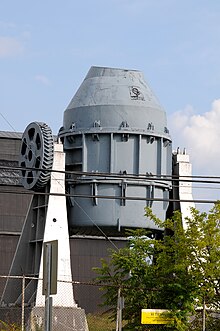McLouth Steel
This complex was built in 1934 by Donald B. McLouth, a Detroit scrap dealer, as a small conversion mill on Livernois Avenue.
General Motors desired additional options for steel, providing partial financing for this facility.
In 1938, the company brought online a single 4-high reversing cold reducing mill with ancillary facilities (annealing and finishing).
With this new addition to the Detroit plant, stainless steel production increased to 52,000 net tons per year.
The line consisted of an entry end washing section to remove rolling oils, an open air annealing furnace (where the strip was heated above 1,900 °F (1,040 °C)), and three acid pickling tanks followed by rinsing and drying units.
[1] Purchasing war surplus equipment from a Chicago mill (at bargain prices),[2] the first major construction program started soon afterward.
In the summer of 2009, after several failed start-up attempts, the Trenton complex had its electrical distribution infrastructure removed.
In 1954, McLouth announced the construction of a cold rolling facility in Gibraltar, Michigan, close to the Trenton Plant.
[5] McLouth turned to the rest of the world to search for a solution, finding in Austria the basic oxygen furnace.
[5] As the process was refined and perfected (and larger furnaces were added), this technology enabled McLouth to average 30% higher profits than its competitors between 1960 and 1966.
McLouth Steel used a General Electric 312 computer for gauge control on the finishing train of a semi-continuous mill.
The aim was to set up the initial roll gap and then establish correct gauge as soon as the head end of the strip emerged onto the runout table.
This required continuous high speed feedback to set the six different hot stands with absolute accuracy and reliability being essential; an error at one point could be magnified at the next, causing an entire process to go out of control.
The solid state circuitry of a GE 312 computer was composed of 2500 diodes, 2500 transistors, and 12,000 resistors, but no magnetic core memory.
Some sixteen months later, McLouth was operating a "straight stick" casting machine, the first in the United States.
In 1963, a full-size single-strand, vertical casting machine was added to the original Oxygen Process Shop.
The pilot shop was operated mostly during the day, while the afternoon and midnight shifts would repair, modify, or tune the machine.
The pilot plant was limited to about 50 "heats" (ladles of molten steel) from the original OP shop.
The five-year run of the plant produced the opportunity to help develop both the equipment and casting techniques.
Extensive work was performed on the design of the molds and the casting speed relative to the slab quality.
The depth of penetration is determined by the frequency of the electrical power supply and the metallurgical makeup of the steel.
After discussions, McLouth entered into a shared cost, joint development venture with the company to design, build, and test a prototype coil system.
Early in 1965, several small 12" thick slabs of rimmed steel were repetitively heated in a prototype 1,000 kW rectangular coil.
The next year, McLouth ordered 21 heaters (including three spares) as part of a $105 million program expected to be completed by the summer of 1968.
A full-size computer system was installed to automatically switch heaters on or off as required to rebalance the phase loading and to remove the threat of a 120 KV line outage.
When all 18 heaters were running at full capacity, McLouth Steel was Michigan's second largest consumer of electricity (first was the city of Detroit).
The environmental impact was very low due to a closed water cooling system and heaters being shut off during non-operating hours.
[10] McLouth had an extremely generous wage package, something the union was cooperative about reducing in later years as the need to cut costs increased.
[6] Aging and incorrectly sized equipment paired with low employee morale and productivity in the 1980s and 1990s subsequently lowered the quality of steel, creating reputation problems.
These factors, in addition to the economic conditions of the era, helped bring about the closure of a small, innovative, integrated steel company.

